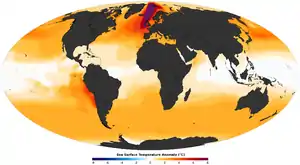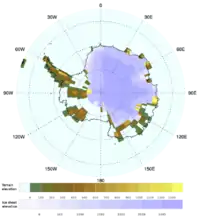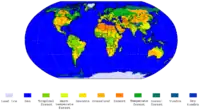

During the Pliocene epoch (5.3 Ma to 2.6 Ma), the Earth's climate became cooler and drier, as well as more seasonal, marking a transition between the relatively warm Miocene to the cooler Pleistocene.[1]
However, the global average temperature in the mid-Pliocene (3.3 Ma–3 Ma) was 2–3 °C higher than today,[2] global sea level 25 meters higher,[3] and the northern hemisphere ice sheet was ephemeral before the onset of extensive glaciation over Greenland that occurred in the late Pliocene around 3 Ma.[4] The formation of an Arctic ice cap is signaled by an abrupt shift in oxygen isotope ratios,[5] the appearance of ice-rafted cobbles in the North Atlantic and North Pacific ocean beds,[6] and high-resolution rock magnetic records indicating iceberg surges.[5] Mid-latitude glaciation was probably underway before the end of the epoch. The global cooling that occurred during the Pliocene may have spurred on the disappearance of forests and the spread of grasslands and savannas.[7]
During the Pliocene the earth climate system response shifted from a period of high frequency-low amplitude oscillation dominated by the 41,000-year period of Earth's obliquity to one of low-frequency, high-amplitude oscillation dominated by the 100,000-year period of the orbital eccentricity characteristic of the Pleistocene glacial-interglacial cycles.[8]
The equatorial Pacific Ocean sea surface temperature gradient was considerably lower than it is today. Mean sea surface temperatures in the east were substantially warmer than today but similar in the west. This condition has been described as a permanent El Niño state, or “El Padre.”[9] Several mechanisms have been proposed for this pattern, including increased tropical cyclone activity.[10]
Setting
During the late Pliocene and early Pleistocene Series of the Cenozoic Era, 3.6 to 2.2 Ma (million years ago), the Arctic was much warmer than it is at the present day (with summer temperatures some 8 °C warmer than today). That is a key finding of research into a lake-sediment core obtained in Eastern Siberia, which is of exceptional importance because it has provided the longest continuous late Cenozoic land-based sedimentary record thus far.[11]
Central Asia became more seasonal during the Pliocene, with colder, drier winters and wetter summers, which contributed to an increase in the abundance of C4 plants across the region.[12] In the Loess Plateau, δ13C values of occluded organic matter increased by 2.5% while those of pedogenic carbonate increased by 5% over the course of the Late Miocene and Pliocene, indicating increased aridification.[13] Further aridification of Central Asia was caused by the development of Northern Hemisphere glaciation during the Late Pliocene.[14] A sediment core from the northern South China Sea shows an increase in dust storm activity during the middle Pliocene.[15]
In the south-central Andes, an arid period occurred from 6.1 to 5.2 Ma, with another occurring from 3.6 to 3.3 Ma. These arid periods are coincident with global cold periods, during which the position of the Southern Hemisphere westerlies shifted northward and disrupted the South American Low Level Jet, which brings moisture to southeastern South America.[16]
In northwestern Africa, tropical forests extended up to Cape Blanc during the Zanclean until around 3.5 Ma. During the Piacenzian, from about 3.5 to 2.6 Ma, the region was forested at irregular intervals and contained a significant Saharan palaeoriver until 3.35 Ma, when trade winds began to dominate over fluvial transport of pollen. Around 3.26 Ma, a strong aridification event that was followed by a return to more humid conditions, which was itself followed by another aridification around 2.7 Ma. From 2.6 to 2.4 Ma, vegetation zones began repeatedly shifting latitudinally in response to glacial-interglacial cycles.[17]
The climate of eastern Africa was very similar to what it is today. Unexpectedly, the expansion of grasslands in eastern Africa during this epoch appears to have been decoupled from aridification and not caused by it, as evidenced by their asynchrony.[18]
Southwestern Australia hosted heathlands, shrublands, and woodlands with a greater species diversity compared to today during the Middle and Late Pliocene. Three different aridification events occurred around 2.90, 2.59, and 2.56 Ma, and may have been linked to the onset of continental glaciation in the Arctic, suggesting that vegetation changes in Australia during the Pliocene behaved similarly to during the Late Pleistocene and were likely characterised by comparable cycles of aridity and humidity.[19]
Onset of glaciation
Greenland ice sheet
Several mechanisms have been proposed to explain global cooling after 3 Ma and the onset of extensive northern hemisphere glaciation.
Panama seaway closure
The closure of the Panama seaway (13 Ma–2.5 Ma) increased the salinity contrast between Pacific and Atlantic Ocean and the northward oceanic heat transport. Warmer water increased snowfall and possibly Greenland ice sheet volume.[20] However, model simulations suggest reduced ice volume due to increased ablation at the edge of the ice sheet under warmer conditions.[21]
Southward shift of the North Atlantic Current
A dinoflagellate cyst turnover in the eastern North Atlantic approximately ~2.60 Ma, during MIS 104, has been cited as evidence that the North Atlantic Current (NAC) shifted significantly to the south at this time, causing an abrupt cooling of the North Sea and northwestern Europe. This reduction in heat transport to high latitude waters of the North Atlantic may have triggered the rapid cooling of the Northern Hemisphere and the development of major glaciation.[22]
Collapse of permanent El Niño
A permanent El Niño state existed in the early-mid-Pliocene. Warmer temperature in the eastern equatorial Pacific caused an increased water vapor greenhouse effect and reduced the area covered by highly reflective stratus clouds, thus decreasing the albedo of the planet. Propagation of the El Niño effect through planetary waves may have warmed the polar region and delayed the onset of glaciation in the northern hemisphere. Therefore, the appearance of cold surface water in the east equatorial Pacific around 3 million years ago may have contributed to global cooling and modified the global climate’s response to Milankovitch cycles.[23]
Uplift of the Rocky Mountains and Greenland’s west coast
Uplift of the Rocky Mountains and Greenland’s west coast may have cooled the climate due to jet stream deflection and increased snowfall due to higher surface elevation.[21]
Carbon dioxide
Carbon dioxide concentration during the Middle Pliocene has been estimated at around 400 ppmv from 13C/12C ratio in organic marine matter.[24] and stomatal density of fossilised leaves.[25] Decreasing carbon dioxide levels during the late Pliocene may have contributed substantially to global cooling and the onset of northern hemisphere glaciation.[26][21] This decrease in atmospheric carbon dioxide concentrations may have come about by way of the decreasing ventilation of deep water in the Southern Ocean.[27]
West Antarctic ice sheet

The extent of the West Antarctic Ice Sheet oscillated at the 40 kyr period of Earth's obliquity. Ice sheet collapse occurred when the global average temperature was 3 °C warmer than today and carbon dioxide concentration was at 400 ppmv. This resulted in open waters in the Ross Sea.[28] Global sea-level fluctuation associated with ice-sheet collapse was probably up to 7 meters for the west Antarctic and 3 meters for the east Antarctic.
Model simulations are consistent with reconstructed ice-sheet oscillations and suggest a progression from a smaller to a larger west Antarctic ice sheet in the last 5 million years. Intervals of ice sheet collapse were much more common in the early-mid Pliocene (5 Ma – 3 Ma), after three-million-year intervals with modern or glacial ice volume became longer and collapse occurs only at times when warmer global temperature coincide with strong austral summer insolation anomalies.[29]
Mid-Pliocene and future climate

The mid-Pliocene warm period, also known as the mid-Piacenzian Warm Period (mPWP),[30] is considered a potential analogue of future climate. The intensity of the sunlight reaching the Earth, the global geography, and carbon dioxide concentrations were similar to present. Furthermore, many mid-Pliocene species are extant, helping calibrate paleotemperature proxies. Model simulations of mid-Pliocene climate produce warmer conditions at middle and high latitudes, as much as 10–20 °C warmer than today above 70°N. They also indicate little temperature variation in the tropics. Model-based biomes are generally consistent with Pliocene palaeobotanical data indicating a northward shift of the tundra and taiga and an expansion of savanna and warm-temperate forest in Africa and Australia.[31]
See also
References
- ↑ Fauquette, Séverine; Bertini, Adele (28 June 2008). "Quantification of the northern Italy Pliocene climate from pollen data: evidence for a very peculiar climate pattern". Boreas. 32 (2): 361–369. doi:10.1111/j.1502-3885.2003.tb01090.x.
- ↑ Robinson, M.; Dowsett, H. J.; Chandler, M. A. (2008). "Pliocene role in assessing future climate impacts" (PDF). Eos. 89 (49): 501–502. Bibcode:2008EOSTr..89..501R. doi:10.1029/2008EO490001. Archived from the original (PDF) on 2011-10-22.
- ↑ Dwyer, G. S.; Chandler, M. A. (2009). "Mid-Pliocene sea level and continental ice volume based on coupled benthic Mg/Ca palaeotemperatures and oxygen isotopes" (PDF). Philosophical Transactions of the Royal Society A. 367 (1886): 157–168. Bibcode:2009RSPTA.367..157D. doi:10.1098/rsta.2008.0222. hdl:10161/6586. PMID 18854304. S2CID 3199617. Archived from the original (PDF) on 2011-10-21.
- ↑ Bartoli, G.; et al. (2005). "Final closure of Panama and the onset of northern hemisphere glaciation". Earth and Planetary Science Letters. 237 (1–2): 33–44. Bibcode:2005E&PSL.237...33B. doi:10.1016/j.epsl.2005.06.020.
- 1 2 Hayashi, Tatsuya; Ohno, Masao; Acton, Gary; Guyodo, Yohan; Evans, Helen F.; Kanamatsu, Toshiya; Komatsu, Fumiki; Murakami, Fumi (2 September 2010). "Millennial-scale iceberg surges after intensification of Northern Hemisphere glaciation". Geochemistry, Geophysics, Geosystems. 11 (9): 1–14. Bibcode:2010GGG....11.9Z20H. doi:10.1029/2010GC003132. S2CID 129503195.
- ↑ Van Andel, Tjeerd H. (28 October 1994). New Views on an Old Planet: A History of Global Change. Cambridge University Press. p. 226. ISBN 978-0521447553.
- ↑ Polly, D.; et al. (10 April 2011). "The Pliocene epoch". University of California Museum of Paleontology. Retrieved 2012-08-31.
- ↑ Dowsett, H. J.; Chandler, M. A.; Cronin, T. M.; Dwyer, G. S. (2005). "Middle Pliocene sea surface temperature variability" (PDF). Paleoceanography. 20 (2): PA2014. Bibcode:2005PalOc..20.2014D. CiteSeerX 10.1.1.856.1776. doi:10.1029/2005PA001133. Archived from the original (PDF) on 2011-10-22.
- ↑ Fedorov, A. V.; et al. (2006). "The Pliocene paradox (mechanisms for a permanent El Niño)". Science. 312 (5779): 1485–1489. Bibcode:2006Sci...312.1485F. CiteSeerX 10.1.1.143.5772. doi:10.1126/science.1122666. PMID 16763140. S2CID 36446661.
- ↑ Fedorov, Alexey V.; Brierley, Christopher M.; Emanuel, Kerry (February 2010). "Tropical cyclones and permanent El Niño in the early Pliocene epoch". Nature. 463 (7284): 1066–1070. Bibcode:2010Natur.463.1066F. doi:10.1038/nature08831. hdl:1721.1/63099. ISSN 0028-0836. PMID 20182509. S2CID 4330367.
- ↑ Mason, John. "The last time carbon dioxide concentrations were around 400ppm: a snapshot from Arctic Siberia". Skeptical Science. Retrieved 30 January 2014.
- ↑ Shen, Xingyan; Wan, Shiming; Colin, Christophe; Tada, Ryuji; Shi, Xuefa; Pei, Wenqiang; Tan, Yang; Jiang, Xuejun; Li, Anchun (15 November 2018). "Increased seasonality and aridity drove the C4 plant expansion in Central Asia since the Miocene–Pliocene boundary". Earth and Planetary Science Letters. 502: 74–83. Bibcode:2018E&PSL.502...74S. doi:10.1016/j.epsl.2018.08.056. S2CID 134183141. Retrieved 1 January 2023.
- ↑ Gallagher, Timothy M.; Serach, Lily; Sekhon, Natasha; Zhang, Hanzhi; Wang, Hanlin; Ji, Shunchuan; Chang, Xi; Lu, Huayu; Breecker, Daniel O. (25 November 2021). "Regional Patterns in Miocene-Pliocene Aridity Across the Chinese Loess Plateau Revealed by High Resolution Records of Paleosol Carbonate and Occluded Organic Matter". Paleoceanography and Paleoclimatology. 32 (12). Bibcode:2021PaPa...36.4344G. doi:10.1029/2021PA004344. S2CID 244702210. Retrieved 1 January 2023.
- ↑ Sun, Youbin; An, Zhisheng (1 December 2005). "Late Pliocene-Pleistocene changes in mass accumulation rates of eolian deposits on the central Chinese Loess Plateau". Journal of Geophysical Research. 110 (D23): 1–8. Bibcode:2005JGRD..11023101S. doi:10.1029/2005JD006064.
- ↑ Süfke, Finn; Kaboth-Barr, Stefanie; Wei, Kuo-Yen; Chuang, Chih-Kai; Gutjahr, Marcus; Pross, Jörg; Friedrich, Oliver (15 September 2022). "Intensification of Asian dust storms during the Mid-Pliocene Warm Period (3.25–2.96 Ma) documented in a sediment core from the South China Sea". Quaternary Science Reviews. 292. Bibcode:2022QSRv..29207669S. doi:10.1016/j.quascirev.2022.107669. S2CID 251426879. Retrieved 25 June 2023.
- ↑ Amidon, William H.; Fisher, G. Burch; Burbank, Douglas W.; Ciccioli, Patricia L.; Alonso, Ricardo N.; Gorin, Andrew L.; Silverhart, Perry H.; Kylander-Clark, Andrew R. C.; Christoffersen, Michael S. (12 June 2017). "Mio-Pliocene aridity in the south-central Andes associated with Southern Hemisphere cold periods". Proceedings of the National Academy of Sciences of the United States of America. 114 (25): 6474–6479. Bibcode:2017PNAS..114.6474A. doi:10.1073/pnas.1700327114. PMC 5488932. PMID 28607045.
- ↑ Leroy, Suzanne; Dupont, Lydie (June 1994). "Development of vegetation and continental aridity in northwestern Africa during the Late Pliocene: the pollen record of ODP site 658". Palaeogeography, Palaeoclimatology, Palaeoecology. 109 (2–4): 295–316. Bibcode:1994PPP...109..295L. doi:10.1016/0031-0182(94)90181-3. Retrieved 31 December 2022.
- ↑ Blumenthal, Scott A.; Levin, Naomi E.; Brown, Francis H.; Brugal, Jean-Philip; Chritz, Kendra L.; Harris, John M.; Jehle, Glynis E.; Cerling, Thure E. (26 June 2017). "Aridity and hominin environments". Proceedings of the National Academy of Sciences of the United States of America. 114 (28): 7331–7336. Bibcode:2017PNAS..114.7331B. doi:10.1073/pnas.1700597114. PMC 5514716. PMID 28652366.
- ↑ Dodson, J. R.; Macphail, M. K. (July 2004). "Palynological evidence for aridity events and vegetation change during the Middle Pliocene, a warm period in Southwestern Australia". Global and Planetary Change. 41 (3–4): 285–307. Bibcode:2004GPC....41..285D. doi:10.1016/j.gloplacha.2004.01.013. Retrieved 31 December 2022.
- ↑ Haug, G. H.; Tiedemann, R. (1998). "Effect of the formation of the Isthmus of Panama on Atlantic Ocean thermohaline circulation". Nature. 393 (6686): 673–676. Bibcode:1998Natur.393..673H. doi:10.1038/31447. S2CID 4421505.
- 1 2 3 Lunt, D. J.; Foster, G. L.; Haywood, A. M.; Stone, E. J. (2008). "Late Pliocene Greenland glaciation controlled by a decline in atmospheric CO2 levels". Nature. 454 (7208): 1102–1105. Bibcode:2008Natur.454.1102L. doi:10.1038/nature07223. PMID 18756254. S2CID 4364843.
- ↑ Hennissen, Jan A. I.; Head, Martin J.; De Schepper, Stijn; Groeneveld, Jeroen (15 May 2014). "Palynological evidence for a southward shift of the North Atlantic Current at ~2.6 Ma during the intensification of late Cenozoic Northern Hemisphere glaciation". Paleoceanography and Paleoclimatology. 29 (6): 564–580. Bibcode:2014PalOc..29..564H. doi:10.1002/2013PA002543.
- ↑ Philander, S. G.; Fedorov, A. V. (2003). "Role of tropics in changing the response to Milankovich forcing some three million years ago". Paleoceanography. 18 (2): 1045. Bibcode:2003PalOc..18.1045P. doi:10.1029/2002PA000837.
- ↑ Raymo, M. E.; Grant, B.; Horowitz, M.; Rau, G. H. (1996). "Mid-Pliocene warmth: Stronger greenhouse and stronger conveyor". Marine Micropaleontology. 27 (1–4): 313–326. Bibcode:1996MarMP..27..313R. doi:10.1016/0377-8398(95)00048-8.
- ↑ Kurschner, W. M.; van der Burgh, J.; Visscher, H.; Dilcher, D. L. (1996). "Oak leaves as biosensors of late Neogene and early Pleistocene paleoatmospheric CO2 concentration". Marine Micropaleontology. 27 (1–4): 299–312. Bibcode:1996MarMP..27..299K. doi:10.1016/0377-8398(95)00067-4.
- ↑ Bartoli, Gretta; Hönisch, Bärbel; Zeebe, Richard E. (16 November 2011). "Atmospheric CO2 decline during the Pliocene intensification of Northern Hemisphere glaciations". Paleoceanography and Paleoclimatology. 26 (4): 1–14. Bibcode:2011PalOc..26.4213B. doi:10.1029/2010PA002055.
- ↑ Hodell, David A.; Venz-Curtis, Kathryn A. (6 September 2006). "Late Neogene history of deepwater ventilation in the Southern Ocean". Geochemistry, Geophysics, Geosystems. 7 (9): 1–16. Bibcode:2006GGG.....7.9001H. doi:10.1029/2005GC001211. S2CID 129085686.
- ↑ Naish, T.; et al. (2009). "Obliquity-paced Pliocene West Antarctic ice sheet oscillations". Nature. 458 (7236): 322–328. Bibcode:2009Natur.458..322N. doi:10.1038/nature07867. PMID 19295607. S2CID 15213187.
- ↑ Pollard, D.; DeConto, R. M. (2009). "Modelling West Antarctic ice sheet growth and collapse through the past five million years". Nature. 458 (7236): 329–332. Bibcode:2009Natur.458..329P. doi:10.1038/nature07809. PMID 19295608. S2CID 4427715.
- ↑ De la Vega, Elwyn; Chalk, Thomas B.; Wilson, Paul A.; Bysani, Ratna Priya; Foster, Gavin L. (9 July 2020). "Atmospheric CO2 during the Mid-Piacenzian Warm Period and the M2 glaciation". Scientific Reports. 10 (1): 11002. Bibcode:2020NatSR..1011002D. doi:10.1038/s41598-020-67154-8. PMC 7347535. PMID 32647351.
- ↑ Salzmann, U.; Haywood, A. M.; Lunt, D. J. (2009). "The past is a guide to the future? Comparing Middle Pliocene vegetation with predicted biome distributions for the twenty-first century". Philosophical Transactions of the Royal Society A. 367 (1886): 189–204. Bibcode:2009RSPTA.367..189S. doi:10.1098/rsta.2008.0200. PMID 18854302. S2CID 20422374.